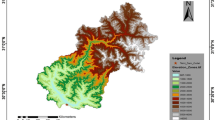Abstract
The objective of this study is to analyze relationships between the variability of MODIS derived snow covered area (SCA) and flood dynamics for the management of reservoirs. The study was conducted in the Nechako River Basin in British Columbia (Canada). Relationships were analyzed between daily SCA calculated from filtered MODIS images and the fraction of the flood volume that had already entered the reservoir during the snowmelt period. Results indicate a robust (R2 = 0.87) and significant (p < 0.001) correlation over a 14-years (2000-2013) period. A similar analysis was conducted for each sub-basin, producing an even more robust relationship (R2 = 0.90) for the Tahtsa Lake sub-basin. Two distinct relationships corresponding to years with either large or small spring runoff were identified by classifying years according to their maximum snow water equivalents (SWE), peak inflows and flood volume, thus improving the correlations. These empirical relationships are a simple forecasting tool that does not require any additional data other than MODIS SCA and SWE measurements. This straightforward approach can be applied to other mountainous watersheds dominated by snow accumulation and melt.






Similar content being viewed by others
References
Ackerman SA, Strabala KI, Menzel WP, Frey RA, Moeller CC, Gumley LE (1998) Discriminating clear sky from clouds with MODIS. J Geophys Res Atmos (1984–2012) 103:32141–32157
Berrada F, Bennis S, Gagnon L (1996) Validation des données hydrométriques par des techniques univariées de filtrage. Can J Civ Eng 23:872–892
Donald JR, Soulis ED, Kouwen N, Pietroniro A (1995) A land cover-based snow cover representation for distributed hydrologic models. Water Resour Res 31:995–1009
Dressler KA, Leavesley GH, Bales RC, Fassnacht SR (2006) Evaluation of gridded snow water equivalent and satellite snow cover products for mountain basins in a hydrologic model. Hydrol Process 20:673–688
Garen DC (1992) Improved techniques in regression-based streamflow volume forecasting. J Water Resour Plan Manag ASCE 118:654–670
Hall DK, Riggs GA (2007) Accuracy assessment of the MODIS snow products. Hydrol Process 21:1534–1547
Hall DK, Foster JL, Chang ATC, Benson CS, Chien JYL (1998) Determination of snow-covered area in different land covers in central Alaska, U.S.A., from aircraft data – April 1995. Ann Glaciol 26:149–155
Hall DK, Riggs GA, Salomonson VV, DiGirolamo NE, Bayr KJ (2002) MODIS snow-cover products. Remote Sens Environ 83:181–194
Hingray B, Picouet C, Musy A (2009) Hydrologie: Une science pour l'ingénieur. PPUR presses polytechniques
Klein AG, Hall DK, Riggs GA (1998) Improving snow cover mapping in forests through the use of a canopy reflectance model. Hydrol Process 12:1723–1744
Lavallée S, Brissette FP, Leconte R, Larouche B (2006) Monitoring snow-cover depletion by coupling satellite imagery with a distributed snowmelt model. J Water Resour Plan Manag 132:71–78
McGuire M, Wood AW, Hamlet AF, Lettenmaier DP (2006) Use of satellite data for streamflow and reservoir storage forecasts in the Snake River Basin. J Water Resour Plan Manag 132:97–110
Painter TH, Rittger K, McKenzie C, Slaughter P, Davis RE, Dozier J (2009) Retrieval of subpixel snow covered area, grain size, and albedo from MODIS. Remote Sens Environ 113:868–879
Parajka J, Blöschl G (2008) Spatio-temporal combination of MODIS images - potential for snow cover mapping. Water Resour Res 44
Rango A, Hannaford JF, Hall RL, Rosenzweig M, Brown AJ (1977) The use of snowcovered area in runoff forecasts. Preprint X-913-77-48, NASA Goddard Space Flight Center
Rango A, Walker A, Goodison B (2000) Snow and ice. In: Remote sensing in hydrology and water management. Springer, pp 239–270
Riggs G, Hall DK (2002) Reduction of cloud obscuration in the MODIS snow data product. In: Proceedings of the 59th Eastern Snow Conference, Stowe, Vermont 5
Riggs GA, Hall DK (2004) Snow mapping with the MODIS Aqua instrument. In: Proceedings of the 61st Eastern Snow Conference, Portland, Maine 9, pp 81–4
Schmugge TJ, Kustas WP, Ritchie JC, Jackson TJ, Rango A (2002) Remote sensing in hydrology. Adv Water Resour 25:1367–1385
Seidel K, Martinec J (2002) NOAA/AVHRR monitoring of snow cover for modelling climate-affected runoff in Ganges and Brahmaputra Rivers. 189
Şensoy A, Uysal G (2012) The value of snow depletion forecasting methods towards operational snowmelt runoff estimation using MODIS and numerical weather prediction data. Water Resour Manag 26:3415–3440
Sorman AA, Sensoy A, Tekeli AE, Sorman AÜ, Akyürek Z (2009) Modelling and forecasting snowmelt runoff process using the HBV model in the eastern part of Turkey. Hydrol Process 23:1031–1040
Turcotte R (2010) Éléments du calage et de l'implantation d'un modèle hydrologique dans une perspective d'utilisation opérationnelle en prévision hydrologique. Doctoral dissertation
Zhou X, Xie H, Hendrickx JMH (2005) Statistical evaluation of remotely sensed snow-cover products with constraints from streamflow and SNOTEL measurements. Remote Sens Environ 94:214–231
Acknowledgments
The authors wish to thank Rio Tinto Alcan (RTA) and the Natural Sciences and Engineering Research Council of Canada (NSERC) for their financial support. We are also thankful to RTA for providing us information and data of the Nechako River Basin. Finally, we want to thank the reviewers for their helpful comments.
Author information
Authors and Affiliations
Corresponding author
Rights and permissions
About this article
Cite this article
Marcil, GK., Trudel, M. & Leconte, R. Using Remotely Sensed MODIS Snow Product for the Management of Reservoirs in a Mountainous Canadian Watershed. Water Resour Manage 30, 2735–2747 (2016). https://doi.org/10.1007/s11269-016-1319-5
Received:
Accepted:
Published:
Issue Date:
DOI: https://doi.org/10.1007/s11269-016-1319-5




